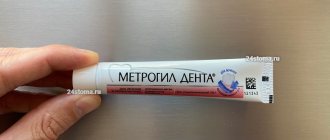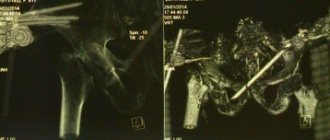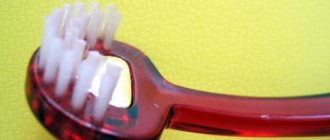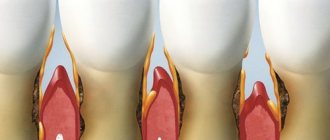When should you use mouthwash?
With halitosis. If bad breath occurs frequently, a mouthwash will help remove it. It reduces the number of bacteria, slows down their reproduction, and cleans even those areas that cannot be reached with a toothbrush (subgingival, interdental areas, surface of the tongue, gums, cheeks). When rinsing, residues and food particles are washed away, which can cause an unpleasant odor.
If caries appears frequently. It is formed when plaque accumulates on the enamel, when the acidity in the mouth becomes too high (including due to the active growth of bacteria). Antibacterial solutions help reduce acidity, and additional cleansing reduces plaque formation. The mouthwash may contain fluorides or other mineral components that strengthen the enamel, restore its structure, and protect against caries.
With the rapid appearance of tartar. It is formed when soft plaque hardens. It can only be removed with professional cleaning. To prevent tartar from appearing again, effective hygiene is important. Using rinses, you can slow down the formation of deposits: they wash the enamel surface, remove food particles, slow down the growth of bacteria, and help keep teeth clean throughout the day.
If the enamel is highly sensitive. In this case, you need to use solutions with a mineralizing effect. They must contain fluorides. When rinsed, they penetrate the enamel structure, restore it, strengthen it and reduce sensitivity. It’s good if the solution is also antibacterial: it will help reduce acidity in the mouth, eliminating pain.
For bleeding or inflammation of the gums. The use of solutions with anti-inflammatory and antibacterial effects is part of the prevention and treatment of gum disease. They help relieve inflammation, accelerate the healing of the mucous membrane, and slow down the formation of tartar under the gingival margin.
Proper dental care in old age
In principle, dental care in old age and young age consists of many similar stages. The difference lies in the aids and products. To make life easier for older people, special toothbrushes with large, strong handles have been created, as well as modern electric toothbrushes that make daily oral hygiene easier. As you get older, brushing your teeth thoroughly is very important. As you age, your risk of severe periodontitis and aggressive root caries, a common cause of tooth loss, increases. Unfortunately, gums recede as we age, and exposed tooth necks become a problem. In addition, the distance between the teeth increases. It is necessary to brush your teeth more carefully, for example, with brushes with rounded bristles or suitable brushes for interdental spaces. Mouthwashes and special tongue cleaners can help combat tooth decay and bad breath. They penetrate into corners that remain virtually inaccessible to electric brushes.
To eliminate conditions conducive to the development of infection in the oral cavity of geriatric patients, rinsing with weak aqueous solutions of antiseptics, for example: 2% boric acid solution, is recommended after each meal and additionally several times a day; 0.05% solution of chlorhexidine bigluconate.
Algorithm for brushing teeth at home:
It is necessary to brush your teeth thoroughly at least 2 times a day. Best of all, 3 times, each time about half an hour after eating.
Interdental spaces and hard-to-reach areas can be cleaned well with interdental brushes, which are available in different sizes.
Fluoride toothpaste helps restore the balance of minerals in teeth and reduces the risk of tooth decay.
Flossing is easier if the floss is taut on holders shaped like a toothbrush.
A tongue cleaner removes bacterial plaque from the tongue.
A specific and not too spicy mouthwash that freshens breath and kills bacteria.
What types of mouth rinses can there be?
For self-hygiene, solutions with antibacterial, antiseptic, mineralizing, anti-inflammatory, and antifungal effects can be used. It is better to use a rinse selected by your dentist or hygienist, taking into account the condition of your teeth and gums.
Mineralizing. The basis of the solution is sodium fluoride or olafur. This is a mineral component that can penetrate the enamel structure and strengthen it. After rinsing, a protective film is formed on the surface of the teeth. It lasts for several hours, “saturating” the enamel with minerals. The use of such rinses reduces the risk of caries and reduces the sensitivity of enamel.
Antiseptic. The main component may be chlorhexidine, triclosan, or benzydamine in low concentrations. The solution destroys bacteria, protects against gum disease, slows down the formation of tartar, and improves the condition of gingivitis and some other diseases. After tooth extraction, rinsing with antiseptic solutions may be prescribed to reduce the risk of inflammation or dry socket formation. Rinse aids with an antiseptic effect are used as prescribed by the attending physician. They are usually used as part of complex therapy in the treatment of periodontitis, gingivitis and other inflammatory diseases. You cannot use them for too long: this is dangerous due to dysbacteriosis of the oral cavity, dry mucous membranes, and the appearance of halitosis.
Health-improving. They are made from extracts or decoctions of herbs, using essential oils. The effect is mild, supportive or preventive (not pronounced enough if treatment of existing diseases is needed). Such rinses can contain extracts of chamomile, myrrh, sage, eucalyptus, sea buckthorn, hawthorn, essential oil of geranium and other plants. Their effect is anti-inflammatory, restorative, restoring local immunity. Such products are used as a means of daily hygiene. Even with long-term use they do not cause side effects.
Alcohol based. They are classified as antiseptic, used as prescribed by a doctor, the ethanol content can be up to 27%. Effective for halitosis and inflammatory diseases of the oral cavity. They cannot be used by minors, people for whom alcohol is contraindicated, or drivers (after rinsing, the breath may contain alcohol vapor, and this is recorded during testing with a breathalyzer).
Some rinses are used as prescribed by a doctor for specific diseases or conditions. They may include:
- diphenhydramine - for a local allergic reaction;
- xylocaine or lidocaine - anesthetic effect (temporarily removes sensitivity);
- nystatin, betamethasone, stomatidine - for aphthous stomatitis and other acute inflammations;
- benzydamine is a pain reliever.
Oral care for a patient receiving palliative care
Contents Types of lesions of the oral mucosa
Factors contributing to the disease
Stages of damage to the oral mucosa
Treatment
Caring for the patient's oral cavity with xerostomia
Caring for the patient's oral cavity with hypersalivation
Lesions of the oral mucosa are a painful condition for the patient, and they often occur in palliative patients. The head physician of the Samara hospice, Olga Vasilievna Osetrova, spoke in detail about how to cope with these problems.
Types of damage to the oral mucosa
Any pathological process is reflected in the mucous membrane (SM) of the oral cavity. The mouth is home to a large number of bacteria. Normally, they coexist, participating in the process of primary food processing. But in the presence of unfavorable factors, especially in weakened patients, the composition of the oral microflora changes: the number of pathogens that cause diseases of the oral mucosa increases and, as a result, inflammation, suppuration, erosion, ulcers and other tissue damage occur.
Elements of damage are conventionally divided into primary (arising on unchanged CO) and secondary (developing as a result of transformation or damage to existing changes).
The primary elements of the rash include: spot, nodule (papule), node, blister, abscess (pustule), cyst.
Secondary : erosion, excoriation, aphthae, ulcer, fissure, crust, scar.
Depending on the location of the lesion, they are classified into stomatitis, glossitis, and gingivitis .
For cancer patients, the umbrella term often used is mucositis. Mucositis is a post-radiation and post-chemotherapy erosive or ulcerative-necrotic lesion of the mucous membranes of the oral cavity and other parts of the gastrointestinal tract, with a predominant localization in the mouth and pharynx.
Problems of the oral mucosa also include xerostomia (dryness) and hypersalivation - increased salivation.
Factors contributing to the disease
- The presence of a source of infection in the body;
- Weakened immunity (with cancer, radiation therapy, chemotherapy, AIDS, chronic stress, etc.);
- Hypo- and vitamin deficiencies;
- Anemia;
- Hormonal imbalance;
- Chronic diseases (gastrointestinal tract, diabetes, chronic renal failure, allergies, etc.);
- Medicines (diuretics, antibiotics);
- Dehydration;
- Diseases of teeth and gums;
- Poor oral hygiene;
- Damage to the mucosa - mechanical, thermal, chemical (including chemotherapy).
Symptoms that should alert you:
- Strong bad breath;
- Swelling and bleeding gums;
- Formations (ulcers, rashes, abscesses) on the tongue, gums, mucous membranes;
- Pain, burning, which intensifies while eating;
- Increased salivation or severe dry mouth.
Stages of damage to the oral mucosa
“0” – no changes;
“1” – the gums are red, swollen, signs of mucosal atrophy are detected;
“2” – small ulcers of small size, without pain, which do not interfere with eating or talking;
“3” – aphthous formations become larger and increase in number, a capillary pattern is visible on the gums, it is difficult to eat;
“4” is the most difficult stage, characterized by a deterioration in the patient’s general condition; there are multiple ulcers of various sizes and shapes on the oral mucosa; the person cannot even consume liquid food and drinks.
Treatment of lesions of the oral mucosa
Determining the cause of the disease and, if possible, eliminating it.
Regular hygienic oral care (also necessary at the prevention stage):
Carry out the procedure for cleansing the oral cavity every morning and evening, as well as after each meal and after bouts of vomiting. Severely ill people are at increased risk of oral infections and require ongoing care.
You will need : a brush (select a toothbrush based on softness) and a spatula for the oral cavity, gauze napkins, freshly squeezed lemon juice with glycerin (1:2) or special cotton swabs for oral care, if there are problems on the mucous membrane - local antiseptics in a convenient patient form (tablets, spray, ointment), container for spitting; waterproof diaper or towel.
Algorithm:
- turn the patient on his side so that his face is on the edge of the pillow;
- Place an absorbent diaper under his head and on his chest;
- place a container under your chin;
- ask to open your mouth slightly or do it yourself with the patient’s consent;
- Using a “sweeping” motion from top to bottom, run a moistened toothbrush along the lower and upper jaws of the person, repeat several times for at least 30 seconds;
- wrap the spatula in a gauze cloth and soak it in lemon juice with glycerin (or cotton swabs with glycerin or an antiseptic solution - if necessary);
- treat the inner surface of the cheeks, tongue, sublingual area, hard palate. If there are aphthae, ulcers, nodules, be extremely careful, do not touch the healthy and damaged surface with the same napkin;
- Additionally, in case of damage to the mucous membrane, use the necessary medication: gels, ointments, sprays, tablets or rinses.
Important Provide and encourage every opportunity for the patient to perform personal hygiene care as appropriate and safely.
The need for regular treatment of the oral cavity increases with the deterioration of the sick person’s condition.
Be sure to warn the person about your every action. Even if he is unconscious, and, as it seems to you, does not hear or understand.
When a person wears dentures, it is necessary to take them out and carefully carry out oral hygiene to remove food debris and wash the dentures themselves.
You need to be especially attentive and careful when treating the mouth of a patient with dysphagia.
Methods for assessing dysphagia and preventing aspiration in palliative patients What nuances should be taken into account when conducting the “three sips test” in palliative patients, what are the predictors of dysphagia, how to assess and prevent the risk of aspiration Varvara Brusnitsyna
Symptomatic treatment
Nutrition - includes a balanced and complete composition of foods, taken in small portions, food of soft consistency, warm (not hot). Before eating, you can lubricate the mucous membrane with an anesthetic gel. Avoid sour, salty, spicy, allergenic foods, coffee, alcohol; limit sweets (a breeding ground for bacteria, contribute to drying of the mucous membrane). After eating - rinse with warm water or infusions of medicinal herbs; drying and treatment with medicinal agents.
Pharmacotherapy - the use of local anesthetics, antiseptics, non-steroidal anti-inflammatory drugs, antivirals, antibiotics, antihistamines, drugs that promote the healing of epithelial defects. Since there are several diseases that manifest as ulcerative formations on the mucous membrane, it is necessary to carry out both local and specific therapy.
Lesions of the oral mucosa
Preparations for external use
Antifungal drugs:
- clotrimazole ointment 1%
- Candide - solution for topical use
- Hexoral – aerosol, spray, rinse solution
- tantum verde (benzydamine) – spray, solution, tablets
- solution of borax in glycerin
Antiherpetic agents:
- acyclovir (Zovirax)
- Viferon
Local antiviral agents:
- alpizarin ointment 5%
- Viferon - gel
- bonafton ointment
Antiseptics:
- hydrogen peroxide
- furacillin
Binders:
- tannin (solution)
- romazulan
- infusions of medicinal herbs: chamomile, string, sage, St. John's wort, oak bark, calendula
Anti-inflammatory, painkillers, antiseptics:
- Kamistad gel
- lysobacter
- hexalization
- cholisal gel
- Kalgel
- rotokan
- chlorophyllipt 1% solution
- hexoral (stomatidine, stopangin) – solution, spray, contains hexetidine
- lidocaine-Asept (lidocaine + chlorhexidine)
- tantum verde (benzydamine)
- Givalex spray (hexetidine+chlorobutanol+choline salicylate)
- stomatophyte
- chlorhexidine bigluconate
- imudon
- isla
Healing (promoting regeneration):
- solcoseryl
- sebedin
- pyromecaine ointment
Caring for the patient's oral cavity with xerostomia
With a lack of saliva, in addition to discomfort - dryness and soreness in the mouth, there is an increased risk of infection of the mucous membranes. Therefore, regular hygienic treatment of the oral cavity is supplemented by: increasing the number of rinses with softening solutions (water-glycerin mixture) or decoctions (chamomile, string); stimulation of chewing movements (chewing gum without sugar); increasing the volume of fluid you drink (if possible); preference for breathing through the nose.
It is possible to use special moisturizers:
- Bioxtra / Bioxtra oral spray, moisturizing with salivary enzymes
- Hyposalix oral spray
- Bioten gel for moisturizing the oral cavity
Since xerostomia can be caused by medications, such as: tricyclic antidepressants, sedatives, tranquilizers, antihistamines, cytostatics, antiparkinsonian and antiepileptic drugs, in case of severe painful dryness, it is recommended, if possible, to rotate (replace) the drug.
Caring for the patient's oral cavity with hypersalivation
With hypersalivation (ptialism), patients complain of rapid accumulation of saliva in the oral cavity, which forces them to make frequent swallowing movements, while saliva may leak from the corners of the mouth. This, in turn, leads to a violation of the integrity (maceration) of the skin of the chin and lower cheeks, and when a secondary infection occurs, a pustular rash.
The main causes of hypersalivation (salivation) in adults: pathologies of the oral cavity - stomatitis, gingivitis, inflammation of the salivary glands; diseases of the digestive system – gastritis, pancreatitis; neurological disorders - stroke, Parkinson's disease, brain tumors, bulbar palsy, cerebral palsy, trigeminal neuritis, psychosis; taking certain medications - M-cholinomimetics, lithium salts, anticonvulsants.
In addition to regular hygienic treatment of the oral cavity during hypersalivation, treatment of the skin exposed to saliva, including protective agents, is added; additional rinsing of the mouth with solutions containing menthol and/or sage. In particularly difficult cases, the use of anticholinergic drugs (atropine in small doses) is recommended; injections of botulinum toxin into the parotid salivary glands, as a result of which they are paralyzed for 6-8 months.
The material was prepared using a grant from the President of the Russian Federation provided by the Presidential Grants Foundation.
Putting drops into the nose
- Warm the drops to room temperature;
- Before use, the pipette is washed well and its sterile part is sterilized by boiling.
- clean the nasal passages with a sterile cotton swab from mucus and crusts;
- slightly tilt the child’s head back and turn it in the direction in which the medicine will be administered;
- the palm of the left hand is placed on the forehead and the head is fixed, and the tip of the nose is raised with the thumb of the same hand;
- trying not to touch the nasal mucosa with the pipette, inject 2-3 drops of the drug so that it gets on the mucous membrane of the outer wall;
- leave the child's head in the same position for 1-2 minutes to evenly distribute the drug over the mucous membrane;
- then, following the same rules, drops are instilled into the other half of the nose.







